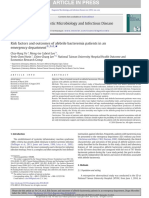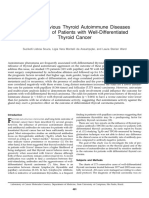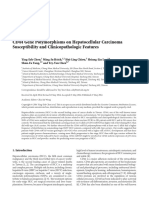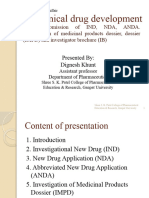1307-Article Text-3852-1-10-20170616
1307-Article Text-3852-1-10-20170616
Uploaded by
Dalila BackupCopyright:
Available Formats
1307-Article Text-3852-1-10-20170616
1307-Article Text-3852-1-10-20170616
Uploaded by
Dalila BackupCopyright
Available Formats
Share this document
Did you find this document useful?
Is this content inappropriate?
Copyright:
Available Formats
1307-Article Text-3852-1-10-20170616
1307-Article Text-3852-1-10-20170616
Uploaded by
Dalila BackupCopyright:
Available Formats
Paediatrica Indonesiana
p-ISSN 0030-9311; e-ISSN 2338-476X; Vol.57, No.3(2017). p. 138-43; doi: http://dx.doi.org/10.14238/pi57.3.2017.138-43
Original Article
CD4+ T-cell, CD8+ T-cell, CD4+/CD8+ ratio,
and apoptosis as a response to induction phase
chemotherapy in pediatric acute lymphoblastic
leukemia
May Fanny Tanzilia1, Andi Cahyadi2, Yetti Hernaningsih3, Endang Retnowati3,
I Dewa Gede Ugrasena2
Abstract correlations between apoptosis and CD4+ (P=0.002; rs=-0.584),
Background Acute lymphoblastic leukemia (ALL) is a neoplastic and CD8+ (rs=-0.556; P=0.004), before chemotherapy. In
disease resulting from somatic mutation in the lymphoid progenitor addition, CD4+-delta and apoptosis-delta also had a significant
cells, often occuring in children aged 2-5 years, predominantly positive correlation (rs=0.478; P=0.016). However, no correlation
in males. Results from the induction phase of chemtherapy are was found between the CD4+/CD8+ ratio and apoptosis, before
used to measure success, but the failure remission rate is still or after chemotherapy.
high. Increased apoptosis of cancer cells, as induced by CD4+ Conclusion There are significantly lower mean CD4+, CD8+,
and CD8+ T-cells, is an indicator of prognosis and response to and CD4+/CD8+ ratio after chemotherapy than before. Also,
chemotherapy. there are significant correlations between CD4+-delta and
Objective To assess for correlations between CD4+, CD8+, or apoptosis-delta, as well as between apoptosis and CD4+, CD8+,
CD4+/CD8+ ratio to the chemotherapy induction phase response and CD4+/CD8+ ratio, before chemotherapy. The CD4+, CD8+,
(i.e., apoptosis) in pediatric ALL patients. and CD4+/CD8+ ratio can be used to predict apoptosis before
Methods This observational analytical cohort study was done chemotherapy. In addition, CD4+-delta can be used to predict
in 25 pediatric ALL patients. Whole blood (3 mL) with EDTA apoptosis-delta as a response to induction phase chemotherapy in
anticoagulant were used to measure absolute counts of CD4+, pediatric ALL. [Paediatr Indones. 2017;57:138-43 doi: http://
CD8+, and CD4+/CD8+ ratio. Peripheral blood mononuclear cells dx.doi.org/10.14238/pi57.3.2017.138-43 ].
(PBMC) were examined for apoptosis. The principle of CD4+,
CD8+ examination was bond between antigens on the surface of Keywords: ALL; CD4+; CD8+; apoptosis
the leukocyte in the blood with fluorochrome labeled antibodies
in the reagents, while the principle of apoptosis examination
was FITC Annexin V will bonds with phosphatidylserine that
moves out of the cell when the cell undergoes apoptosis, then
intercalation with propidium iodide (PI). All examination were
detected by flow cytometry BD FACSCalibur.
From the Clinical Pathology Specialization Program1, Department of Child
Results Subjects were 25 newly-diagnosed, pediatric ALL patients
Health2, and Department of Clinical Pathology3, Airlangga University
(64% males and 36% females). Most subjects were 3 years of age Medical School/Dr. Soetomo Hospital, Surabaya, East Java, Indonesia.
(20%). Numbers of CD4+ and CD8+ cells, as well as CD4+/
CD8+ ratio were significantly decreased after chemotherapy. Reprint requests to: May Fanny Tanzilia, Sukolilo Dian Regency, Makmur
However, apoptosis was not significantly different before and 3/8, Surabaya 60111, East Java, Indonesia. Email: dr.mayfannytanzilia@
after chemotherapy (P=0.689), There were significant negative gmail.com.
138 • Paediatr Indones, Vol. 57, No. 3, May 2017
May F. Tanzilia et al: Response to induction phase chemotherapy in acute lymphoblastic leukemia
A
cute lymphoblastic leukemia (ALL) is a who had never received chemotherapy, and planned
neoplastic disease resulting from somatic to undergo induction phase chemotherapy regularly
mutation in the lymphoid progenitor for 6 weeks. The exclusion criteria were ALL patients
cells in the bone marrow, often occurring with a history of HIV/AIDS or had infections as
in children aged 2-5 years, and predominantly in indicated by fever and other signs. Healthy patients
males. Diagnosis of ALL is based on finding ≥ control were obtained from healthy volunteers aged 1
25% lymphoblasts of blood smear or bone marrow month to 16 years who had investigated no history of
aspiration (BMA) evaluation. Outcome criteria was certain diseases and seem good condition during the
made as follows, < 5% lymphoblasts was belonging to examination was done. This study was approved by
remission, and > 5% was belonging to non remission, the Ethics Committee of our institution and written
including partial remission.1-5 informed consent was obtained from all patients’
Failure of apoptosis and the immune response parents.
causes uncontrolled growth of cancer cells. The Clinical characteristics including age, sex,
progression of ALL has been correlated with hemoglobin (Hb) level, platelet count, and leukocyte
quantitative and qualitative (function) host immune count were obtained at diagnosis (before chemotherapy)
responses. Cluster differentiation 8+ (CD8+) T-cell and after induction phase chemotherapy. Whole blood
are an effector cell resulting an apoptosis tumor (3 mL) with EDTA anticoagulant were used to measure
cells by cytotoxic or cytolytic effects. Anti-tumor absolute counts of CD4+, CD8+, and CD4+/CD8+
mechanisms of CD4+ T-cells are not fully understood. ratio. Reagents used for CD4+, CD8+ examination
The CD4+ T-cells have no cytotoxic or cytolytic was BD Multitest CD3FITC/CD8PE/CD45PerCP/
effects. Many cytokines produced by CD4+ T-cells are CD4APC. The principle of CD4+, CD8+examination
needed for the development of CD8+ effector cells. was to detect bonds between antigens on the surface of
Tumor necrosis factor (TNF) and interferon-gamma the leukocyte present in the blood with fluorochrome
(IFN-gamma) secreted by activated CD4+ T cells labeled antibodies present in the reagents. Peripheral
will induce expression of major histocompatibility blood mononuclear cells (PBMC) were examined
complex I (MHC I) and induce CD8 + T-cell for apoptosis. The FITC Annexin V and propidium
activity to lyse tumor cells.6-10 The induction phase iodide (PI) were used for apoptosis examination. The
of chemotherapy is usually used as a measure of principle of apoptosis examination was FITC Annexin
successful chemotherapy, but remission failure rates V will bonds with phosphatidylserine that moves
are still high.10 Increased apoptosis of cancer cells out of the cell when the cell undergoes apoptosis,
induced by CD4+ or CD8+ T-cells can be used as then intercalation with propidium iodide (PI). The
one indicator of prognosis and response to induction FITC Annexin V can identify early apoptosis, late
phase chemotherapy in pediatric ALL patients.9 The apoptosis and necrosis based on nucleus changes.
aim of this study was to assess for correlations between Propidium Iodide (PI) was used to distinguish late
apoptosis and CD4+, CD8+, and CD4+/CD8+ ratio, apoptosis and necrosis with early apoptosis. All
before and after the induction phase of chemotherapy examination were detected by flow cytometry BD
in pediatric ALL patients. FACSCalibur performed before and after induction
phase chemotherapy, at the Department of Clinical
Pathology, Airlangga University Medical School/
Methods Dr. Soetomo Hospital, Surabaya.
Comparison of Hb levels before and after
This observational, analytical, cohort study included induction phase chemotherapy was evaluated by
25 new cases of pediatric ALL patients who were paired T-test, while leukocyte counts, platelet counts,
diagnosed based on bone marrow aspiration at the CD4+, CD8+ cells, CD4+/CD8+ ratio, and apoptosis
Department of Pediatrics, Airlangga University before and after induction phase chemotherapy were
Medical School/Dr. Soetomo Hospital, Surabaya, from evaluated by Wilcoxon Signed Rank test. Correlations
July to December 2016. The inclusion criteria were of absolute count of CD4+, CD8+ cells, CD4+/CD8+
new cases of pediatric ALL aged 1 month to 16 years ratio with apoptosis were evaluated by Spearman’s
Paediatr Indones, Vol. 57, No. 3, May 2017 • 139
May F. Tanzilia et al: Response to induction phase chemotherapy in acute lymphoblastic leukemia
correlation test. CD4+ -delta was defined as difference (P=0.014) but platelet count was signigficantly higher
between number of CD4+ before and after induction (P=0.000), between before and after induction phase
phase chemotherapy, as well as CD8+-delta, CD4+/ of chemotherapy. Mean numbers of CD4+ and CD8+
CD8+-delta, and apoptosis delta. Results with P cells, as well as CD4+/CD8+ ratio were significantly
values ≤ 0.05 were considered to be statistically decreased after induction phase chemotherapy.
significant. Mean numbers of CD4+ before induction phase
chemotherapy was 3,060.24 (SD 4660.03), after
induction phase chemotherapy was 887.64 (1531.33).
Results Mean numbers of CD8+ before induction phase
chemotherapy was 3,084.76 (SD 4535.51), after
During the study period, 41 new cases of induction phase chemotherapy was 1,647.28 (SD
pediatric ALL patients fulfilled the inclusion criteria, 3644.99). Mean numbers of CD4 +/CD8 + ratio
but 16 patients dropped out, of whom 11 patients before induction phase chemotherapy was 1.12 (SD
died and 5 patients did not complete the induction 0.67), after induction phase chemotherapy was 0.65
phase of chemotherapy. Hence, our cohort study of (SD 0.61). However, apoptosis did not significantly
25 new cases of pediatric ALL patients consisted of decrease after chemotherapy (P=0.689), before
16 males (64%) and 9 females (36%), with a 1.78:1 induction phase chemotherapy was 18.19 (SD 19.82)
ratio (Table 1). Many of our subjects were 3 years of and after induction phase chemotherapy was 14.09
age (20%). Leucocyte count was significantly lower (SD 10.85) (Table 2).
Table 1. Clinical characteristics of study subjects before and after
induction phase chemotherapy
Characteristics N=25 P value
Gender, n
Male 16
Female 9
Age, n
1-5 years 13
6-10 years 7
≥ 10 years 5
Leucocyte count, x103 μL 0.014*
Before
Mean (SD) 52.68 (120.45)
Median (range) 8.81 (1.20 – 585.00)
After
Mean (SD) 7.58 (10.78)
Median (range) 5.12 (0.79 – 56.00)
Hb concentration, g/dL 0.165
Before
Mean (SD) 10.30 (3.13)
Median (range) 9.48 (5.00 – 16.00)
After
Mean (SD) 11.35 (2.02)
Median (range) 11.30 (7.60 – 15.40)
Thrombocyte count, x103 μL 0.000*
Before
Mean (SD) 62.26 (54.17)
Median (range) 42.6 (5.00 – 204.00)
After
Mean (SD) 190.33 (119.07)
Median (range) 177.00 (18.80 – 447.00)
*significant if P ≤ 0.05, Before=before induction phase chemotherapy, After=after induction
phase chemotherapy
140 • Paediatr Indones, Vol. 57, No. 3, May 2017
May F. Tanzilia et al: Response to induction phase chemotherapy in acute lymphoblastic leukemia
Table 2. Comparison between CD4+, CD8+ cells, CD4+/CD8+ ratio, and apoptosis, before and after
induction phase chemotherapy in pediatric ALL patients
Variables Time Mean (SD) Median (range) P value
CD4+, cells Before 3,060.24 (4660.03) 1751.00 (210.0 – 23,016.0 0.000*
After 887.64 (1531.33) 199.00 (4.0 – 5,966.0)
CD8+, cells Before 3,084.76 (4535.51) 1820.00 (341.0 – 18,541.0) 0.004*
After 1,647.28 (3644.99) 423.00 (52.0 – 17,859.0)
CD4+/CD8+ ratio Before 1.12 (0.67) 1.03 (0.33 – 2.91) 0.004*
After 0.65 (0.61) 0.44 (0.06 – 2.31)
Apoptosis Before 18.19 (19.82) 10.83 (0.26 – 80.58) 0.689
After 14.09 (10.85) 10.34 (2.86 – 49.17)
*significant if P ≤ 0.05, Before=before induction phase chemotherapy, After=after induction phase chemotherapy
Table 3. Comparison of apoptosis between pediatric ALL patients and healthy children before
and after induction phase chemotherapy
Apoptosis
Variables P value
Mean (SD) Median (range)
ALL patients (before chemotherapy) 18.19 (19.82) 10.83 (0.26-80.58) 0.683
Healthy control patients 16.21 (3.52) 17.73 (12.19-18.71)
ALL patients (after chemotherapy) 14.09 (10.85) 10.34 (2.86-49.17) 0.316
Healthy control patients 16.21 (3.52) 17.73 (12.19-18.71)
Table 4. Correlation between apoptosis and CD4+, CD8+ cells, and CD4+/CD8+ ratio before
and after induction phase chemotherapy
Correlation with apoptosis before Correlation with apoptosis after
Variables chemotherapy chemotherapy
rs P value rs P value
CD4+ cells - 0.584 0.002 0.081 0.701
CD8+ cells - 0.556 0.004 - 0.105 0.619
CD4+/CD8+ ratio - 0.117 0.579 0.040 0.849
A comparison of apoptosis was done in ALL
patients and healthy control subjects. We found no Discussion
significant differences in apoptosis between the two
groups either before or after chemotherapy (Table Acute lymphoblastic leukemia is a hematological
3). malignancy that often occurs in children, and
We also assessed for correlations between comprises 25–30% of all pediatric malignancies.
apoptosis, before and after chemotherapy, and The highest incidence is in 2–5-year-olds, and
CD4+, CD8+ absolute counts, and CD4+/CD8+ predominantly in boys. Our cohort study of 25 new
ratio. There were significant, negative correlations cases of pediatric ALL patients consisted of 16 (64%)
between apoptosis and CD4+, as well as apoptosis and males and 9 (36%) females, with 1.78 : 1 ratio. Many
CD8+, before chemotherapy. However, there was no subjects were 3 years of age (20%) (Table 1).
significant correlation between CD4+/CD8+ ratio and There were significant differences in leukocyte
apoptosis, before or after chemotherapy (Table 4). (P=0.014) and thrombocyte (P=0.000) counts, before
There was a significant correlation between and after induction phase chemotherapy. Uncontrolled
+
CD4 -delta and apoptosis-delta after induction phase lymphocyte proliferation and defective apoptosis
chemotherapy. However, we observed no significant in ALL patients caused leukocytosis dominated by
correlation between apoptosis-delta and CD8+-delta lymphoblasts. Infiltration of hematopoetic cells by
or CD4+/CD8+-delta (Table 5). leukemic cells accumulated in the bone marrow
Paediatr Indones, Vol. 57, No. 3, May 2017 • 141
May F. Tanzilia et al: Response to induction phase chemotherapy in acute lymphoblastic leukemia
causes anemia and thrombocytopenia. 1,13 After higher than apoptosis in the healthy control group
chemotherapy, leukocyte count decreased, while Hb (Table 3).
level and thrombocyte count increased. Evaluation There was a negative, significant correlation
of bone marrow aspiration after induction phase between apoptosis and CD4+ and CD8+ cells before
chemotherapy showed that all the patients were in chemotherapy (Table 4). This finding indicates that
remission, as determined by leukemic cell clearance greater numbers of CD4+ and CD8+ cells result in
from the bone marrow, mainly in the first 2 weeks after decreased apoptosis. We noted that not only the
induction phase chemotherapy.13 number of CD4+ and CD8+ cells, but their function,
Mean CD4+, CD8+ cells, and CD4+/CD8+ was also important in immune response. The number
ratio were significantly decreased after induction and function of CD4 + and CD8 + cells before
phase chemotherapy (Table 2). Verma et al. reported chemotherapy were correlated with subjects’ response
a significant decrease in B cells, T cells, and NK to chemotherapy and improved survival.10
cells approximately 2 weeks after chemotherapy.14 Apoptosis had no significant correlation
Decreased CD4+/CD8+ ratio after chemotherapy in with CD4 + /CD8 + ratio, either before or after
this study (P=0.004) was due to the larger decrease chemotherapy. Similarly, Dewyer et al. suggested
in CD4+ cells than that in CD8+ cells. Recovery that CD4 + /CD8 + ratio did not correlate with
of CD4+ cells after chemotherapy was slower than tumor response in induction phase chemotherapy.21
recovery of CD8+ cells. Chemotherapy decreases No correlation between CD4+ or CD8+ cells and
the CD4+ and CD8+ cells by increasing regulatory apoptosis after induction phase chemotherapy, may
T cells (T reg), which supress the immune response have been due to decreases of CD4+, CD8+ cells,
by downregulating IL-2, and upregulating IL-10 and and apoptosis after chemotherapy.
TGF-beta. Although IL-10 and TGF-beta are strong, There was a significant correlation between
immunosupressive factors, IL-2 is an important CD4 + - delta (number of CD4 + cells before
immune regulating factor. It is produced by T helper chemotherapy minus the number of CD4+ cells after
cells, which increase T cell proliferation, NK cell chemotherapy) and apoptosis-delta (Table 5). We
activity, and B cell antibody secretion. Past studies found that decreased CD4+ cells lead to decreased
have shown that IL-2 concentration in ALL patients apoptosis. The CD4+ cells had no cytotoxic or cytolytic
is low.15,16 effect on tumor cells, but many cytokines produced by
After chemotherapy, apoptosis was not CD4+ cells are needed for the development of CD8+
significantly decreased (P=0.689). In contrast, into effector cells.6-10
Laane et al. found an increase in apoptosis after The limitations of this study included the lack of
chemotherapy.17 Firstly, our results may have been an extended time to recognize the possibility of future
caused by: 1) sampling time outside the window of relapse or resistance to chemotherapy drugs, apoptosis
maximal effect on apoptosis time (24 - 72 hours). sample preparation was not accompanied by a specific
Liu et al. reported a significant increase in apoptosis marker for lymphocytes, so a series of monocytes may
of lymphoblasts > 24 hours after induction phase have been included, and the sampling time among
chemotherapy in pediatric ALL patients, rather than patients after chemotherapy varied, potentially
in the early hours after chemotherapy.18 Secondly, effecting the decreased apoptosis.
chemotherapy can cause necrosis, so lymphoblasts Comparing the values before and after induction
may not have been detected as apoptotic bodies.19 phase of chemotherapy we conclude that: 1) CD4+
Third, the subjects may have had chemotherapy and CD8+ count cells not significantly higher, 2) there
drug resistance, although 100% of patients entered is no difference in apoptosis, 3) there was a negative
remission,20 and forth, anti-apoptotic proteins levels correlation between apoptosis and CD4+ and CD8+
(e.g., BCL-2, BCL-XL, etc.) in the patients were higher cells before induction phase chemotherapy in pediatric
than pro-apoptotic proteins levels (e.g., BAX, BOK, ALL patients, but no correlation after induction
BCL-Xs, BID, BAD, or Noxa).18 Lymphoblast cells in phase chemotherapy, 4) there is no correlation
ALL patients are more fragile than in healthy children, between CD4+/CD8+ ratio and apoptosis, 5) there
thus, apoptosis in ALL patients was not significantly is a significant correlation between CD4+-delta and
142 • Paediatr Indones, Vol. 57, No. 3, May 2017
May F. Tanzilia et al: Response to induction phase chemotherapy in acute lymphoblastic leukemia
apoptosis-delta, after induction phase chemotherapy. 8. Kresno SB. Ilmu dasar onkologi. 2nd ed. Jakarta: Fakultas
CD4+ and CD8+ cells, and CD4+/CD8+ ratio can Kedokteran Universitas Indonesia; 2011. p. 156-283.
be used to predict apoptosis before chemotherapy, 9. Wong RS. Apoptosis in cancer: from pathogenesis to
while CD4+-delta may be useful to predict apoptosis treatment. J Exp Clin Cancer Res. 2011;30:87.
after induction phase response to chemotherapy in 10. Elzubeir AM, Angi AM, Rahoum HM, Osama A. Prognostic
ALL patients. significance of immune function parameters (CD4, CD8
Suggestions for future research also include and CD4/CD8 ratio) in Sudanese patients with chronic
determining the best time of sampling after lymphocytic leukemia. Int J Multidisciplinary Curr Res.
chemotherapy (24 hours, 36 hours, 48 hours, or 72 2016;4:650-3.
hours) to obtain results with significantly increased 11. Technical Data Sheet BD Multitest CD3 FITC/ CD8 PE/
apoptosis, compared to what our study showed, and CD45 PerCP/ CD4 APC Reagent, BD Pharmingen 2012.
to assess the profile of the percentage of T reg and 12. Technical Data Sheet FITC Annexin V Apoptosis Detection
expression of cytokines in ALL patients before and Kit I, BD Pharmingen 2008.
after chemotherapy. 13. Nguyen VT, Melville A, Nath S, Story C, Howell S, Sutton
R, et al. Bone marrow recovery by morphometry during
induction chemotherapy for acute lymphoblastic leukemia
Conflict of Interest in children. PLoS One. 2015;10:1-10.
14. Verma R, Foster RE, Horgan K, Mounsey K, Nixon H,
None declared. Smalle N, et al. Lymphocyte depletion and repopulation after
chemotherapy for primary breast cancer. Breast Cancer Res.
2016;18:10.
References 15. Salem MP, El-Shanshory MR, El-Desouki NI, Abdou SH,
Attia MA, Zidan AA, et al. Children with acute lymphoblastic
1. Pui CH. Acute lymphoblastic leukemia. In: Williams leukemia show high numbers of CD4+ and CD8+ T-cells
Hematology. Kenneth Kaushansky, Marshall A Lichtman, which are reduced by conventional chemotherapy. Clin
Ernest Beutler, et al., editors. 8th ed. New York The McGraw- Cancer Investig J. 2015;4:603-9.
Hill Companies, Inc.; 2010. p. 1409-30. 16. Wu CP, Qing X, Wu CY, Zhu H, Zhou HY. Immunophenotype
2. Wintrobe, MW. Acute lymphoblastic leukemia in children. and increased presence of CD4(+)CD25(+) regulatory T
In: Wintrobe’s Clinical Hematology. John P Greer, Daniel cells in patients with acute lymphoblastic leukemia. Oncol
A Arber, Bertil Glader, et al., editors. 10th ed. Philadelphia: Lett. 2012;3:421-4.
Lippincott Williams and Wilkins; 2009. p. 2209-60. 17. Laane E, Panaretakis T, Pokrovskaja K, Buentke E, Corcoran
3. Stankovic T, Marston E. Molecular mechanisms involved in M, Soderjall S, et al. Dexamethasone–induced apoptosis in
chemoresistance in paediatric acute lymphoblastic leukaemia. acute lymphoblastic leukemia involves differential regulation
Srp Arh Celok Lek. 2008;136:187-92. of Bcl-2 family members. Haematologica. 2007;92:1460-9.
4. Liang DC, Pui CH. Childhood acute lymphoblatic leukaemia. 18. Liu T, Raetz E, Moos PJ, Perkins SL, Bruggers CS, Smith F,
In: Postgraduate Hematology. A. Victor Hoffbrand, Daniel et al. Diversity of the apoptotic response to chemotherapy in
Catovsky, Edward GD Tuddenham, editors. 5th ed. Ljubljana: childhood leukemia. Leukemia. 2002;16:223-32.
Blackwell Publishing; 2008; p. 542-7. 19. Blagosklonny MV. Cell death beyond apoptosis. Leukemia.
5. Permono B. Leukemia akut. Buku ajar hematologi onkologi 2000;14:1502-8.
anak. Jakarta: Badan Penerbit IDAI; 2010. p.236-47. 20. Niknafs B. Induction of apoptosis and non-apoptosis in
6. Simanjorang C, Kodim N, Tehuteru E. Perbedaan kesintasan 5 human breast cancer cell line (MCF-7) by cisplatin and
tahun pasien leukemia limfoblastik lkut dan mieloblastik akut caffeine. Iran Biomed J. 2011;15;130-3.
pada anak di rumah sakit kanker “Dharmais”. Indonesian J 21. Dewyer NA, Wolf GT, Light E, Worden F, Urba S, Eisbruch A,
Cancer. 2013;7:15-21. et al. Circulating CD4-positive lymphocyte levels as predictor
7. Oluboyo AO, Meludu SC, Onyenekwe CC, Oluboyo BO, of response to induction chemotherapy in patients with
Chianakwanam GU, Emegakor C. Assessment of immune advanced laryngeal cancer. Head Neck. 2014;36:9-14.
stability in breast cancer subjects. Eur Sci J. 2014;10:224-8.
Paediatr Indones, Vol. 57, No. 3, May 2017 • 143
You might also like
- Ziva Meditation Ebook PDFDocument33 pagesZiva Meditation Ebook PDFneeta50% (4)
- Condolence Congratulations and Other Recognition Guidelines PDFDocument4 pagesCondolence Congratulations and Other Recognition Guidelines PDFalsayedmNo ratings yet
- Itil 2011 Process ModelDocument1 pageItil 2011 Process ModelTomas GuillermoNo ratings yet
- Comparison Between Presepsin and Procalcitonin in Early Diagnosis of Neonatal SepsisDocument21 pagesComparison Between Presepsin and Procalcitonin in Early Diagnosis of Neonatal SepsisERIKA PAMELA SOLANO JIMENEZNo ratings yet
- Clinical Features and Major Histocompatibility Complex Genes As Potential Susceptibility Factors in Pediatric Immune ThrombocytopeniaDocument24 pagesClinical Features and Major Histocompatibility Complex Genes As Potential Susceptibility Factors in Pediatric Immune ThrombocytopeniaMerlin Margreth MaelissaNo ratings yet
- Prognostic Variables in Newly Diagnosed Childhood Immune ThrombocytopeniaDocument5 pagesPrognostic Variables in Newly Diagnosed Childhood Immune Thrombocytopeniadhania patraNo ratings yet
- Abstrak FinalDocument1 pageAbstrak FinalpangeranNo ratings yet
- Carey 2005 CD4 Quantitation HIV + Child Antiretroviral TXDocument4 pagesCarey 2005 CD4 Quantitation HIV + Child Antiretroviral TXMaya RustamNo ratings yet
- Treatment Plasmablastic LymphomaDocument35 pagesTreatment Plasmablastic Lymphomavladimirkulf2142No ratings yet
- Current Guidelines For The Management of UKDocument4 pagesCurrent Guidelines For The Management of UKnilacindyNo ratings yet
- Bruin 2004Document7 pagesBruin 2004Vasile Eduard RoșuNo ratings yet
- Risk Factors of Primary Poor Graft Function After Allogeneic Hematopoietic Stem Cell Transplantation in Patients With Myeloid TumorsDocument13 pagesRisk Factors of Primary Poor Graft Function After Allogeneic Hematopoietic Stem Cell Transplantation in Patients With Myeloid TumorsShaza ElkourashyNo ratings yet
- Clinical Epidemiology SGD 1Document6 pagesClinical Epidemiology SGD 1Beatrice Del RosarioNo ratings yet
- PD-L1 Expression in Triple-Negative Breast Cancer: Research ArticleDocument14 pagesPD-L1 Expression in Triple-Negative Breast Cancer: Research ArticleFebrian Parlangga MuisNo ratings yet
- 5TOAUTOJDocument5 pages5TOAUTOJRika FitriaNo ratings yet
- 1548 FullDocument13 pages1548 FullsabarinaramNo ratings yet
- Pediatric Blood Cancer - 2023 - Abstracts From The 39th Annual Meeting of The Histiocyte SocietyDocument64 pagesPediatric Blood Cancer - 2023 - Abstracts From The 39th Annual Meeting of The Histiocyte SocietySeham GoharNo ratings yet
- Lower Vitamin D Levels Are Associated With Increased Risk of Early-Onset Neonatal Sepsis in Term InfantsDocument7 pagesLower Vitamin D Levels Are Associated With Increased Risk of Early-Onset Neonatal Sepsis in Term InfantsMohamed Abo SeifNo ratings yet
- Original PapersDocument6 pagesOriginal PapersfxkryxieNo ratings yet
- Durable Response After Tisagenlecleucel in Adults With Relapsed:refractory Follicular Lymphoma: ELARA Trial UpdateDocument13 pagesDurable Response After Tisagenlecleucel in Adults With Relapsed:refractory Follicular Lymphoma: ELARA Trial UpdateSoumya PoddarNo ratings yet
- Newborn Screening Using TREC KREC AssayDocument9 pagesNewborn Screening Using TREC KREC Assayhiringofficer.amsNo ratings yet
- 100015IJBTIWI2015 WoldieDocument5 pages100015IJBTIWI2015 WoldieSigrid MiNo ratings yet
- Cpho025 02 06Document12 pagesCpho025 02 06Kyung-Nam KohNo ratings yet
- R Codox M Linfoma BurkittDocument8 pagesR Codox M Linfoma BurkittALEXANDER AVILANo ratings yet
- Cell DifferentiationDocument13 pagesCell DifferentiationThembi S'khandzisaNo ratings yet
- Pone 0093162Document16 pagesPone 0093162Ivonne GutierrezNo ratings yet
- Original Article: Clinical and Laboratory Features of Typhoid Fever in ChildhoodDocument6 pagesOriginal Article: Clinical and Laboratory Features of Typhoid Fever in ChildhoodRidha Surya NugrahaNo ratings yet
- Clinical Study: in SituDocument11 pagesClinical Study: in SituemotionaladyNo ratings yet
- Jo2022 3645489Document12 pagesJo2022 3645489Clifford MartinNo ratings yet
- Abstracts For The 27th Annual Scientific Meeting of The Society For Immunotherapy of Cancer (SITC) PDFDocument71 pagesAbstracts For The 27th Annual Scientific Meeting of The Society For Immunotherapy of Cancer (SITC) PDFhigginscribdNo ratings yet
- Parik H 2016Document35 pagesParik H 2016Jose Angel AbadíaNo ratings yet
- CD4 POne 2013Document9 pagesCD4 POne 2013Rika FitriaNo ratings yet
- Red Cell Alloimmunization and Antibody SpecificityDocument6 pagesRed Cell Alloimmunization and Antibody SpecificityLuján GómezNo ratings yet
- TOEFL Kel.4Document13 pagesTOEFL Kel.4Nesti PujiaNo ratings yet
- Comparison of Whole Blood and PBMC Assays ForDocument5 pagesComparison of Whole Blood and PBMC Assays ForFani LonelygirlNo ratings yet
- BLT 10 194Document6 pagesBLT 10 194Mochamad HuseinNo ratings yet
- Post-Infusion CAR T Cells Identify Patients Resistant To CD19-CAR TherapyDocument30 pagesPost-Infusion CAR T Cells Identify Patients Resistant To CD19-CAR TherapyrarreoladNo ratings yet
- Association of The Interferon-C Gene (CA) Repeat Polymorphism With EndometriosisDocument6 pagesAssociation of The Interferon-C Gene (CA) Repeat Polymorphism With EndometriosisGladstone AsadNo ratings yet
- Interferon Gamma Production in The Course of Mycobacterium Tuberculosis InfectionDocument9 pagesInterferon Gamma Production in The Course of Mycobacterium Tuberculosis InfectionAndia ReshiNo ratings yet
- Cancers: /PD-L1 Targeting in Breast Cancer: The FirstDocument25 pagesCancers: /PD-L1 Targeting in Breast Cancer: The Firstrafiqa banoNo ratings yet
- ADR ChemoDocument12 pagesADR Chemohervina ristikasariNo ratings yet
- JCM 08 01175 v2 PDFDocument28 pagesJCM 08 01175 v2 PDFAs'har AnwarNo ratings yet
- Manuscript 4Document4 pagesManuscript 4maryNo ratings yet
- Programmed Death Ligand-1 Expression Is Associated With Poorer Survival in Anal Squamous Cell CarcinomaDocument8 pagesProgrammed Death Ligand-1 Expression Is Associated With Poorer Survival in Anal Squamous Cell CarcinomaAnu ShaNo ratings yet
- Diagnostic Microbiology and Infectious DiseaseDocument5 pagesDiagnostic Microbiology and Infectious DiseasefranciscoreynaNo ratings yet
- Multi Omics Analysis of Tumor Mutation Burden Combined With Immune Infiltrates in Bladder Urothelial CarcinomaDocument15 pagesMulti Omics Analysis of Tumor Mutation Burden Combined With Immune Infiltrates in Bladder Urothelial Carcinomadcssousa8No ratings yet
- Cambios en El Diagnostico de Hepatitis C-Jama 2014Document2 pagesCambios en El Diagnostico de Hepatitis C-Jama 2014Joe Felipe Vera OchoaNo ratings yet
- Autoantibodies Against Complement C1q Correlate With The Thyroid Function in Patients With Autoimmune Thyroid DiseaseDocument6 pagesAutoantibodies Against Complement C1q Correlate With The Thyroid Function in Patients With Autoimmune Thyroid DiseaseSaad MotawéaNo ratings yet
- Souza 2003Document5 pagesSouza 2003MariaLyNguyễnNo ratings yet
- Artigo 30Document7 pagesArtigo 30raudneimNo ratings yet
- A CD40 Agonist and PD-1 Antagonist Antibody Reprogram The Microenvironment of Nonimmunogenic Tumors To Allow T-cell-Mediated Anticancer ActivityDocument16 pagesA CD40 Agonist and PD-1 Antagonist Antibody Reprogram The Microenvironment of Nonimmunogenic Tumors To Allow T-cell-Mediated Anticancer ActivitySoumya PoddarNo ratings yet
- Xia 2016Document29 pagesXia 2016Dewi PrasetiaNo ratings yet
- Paediatric Reference Values For The Peripheral T Cell CompartmentDocument9 pagesPaediatric Reference Values For The Peripheral T Cell CompartmentSubhajitHajraNo ratings yet
- Immunohistochemical Scoring of CD38 in The Tumor MDocument15 pagesImmunohistochemical Scoring of CD38 in The Tumor Mdissanayake.madushikaNo ratings yet
- Ogiya Et Al-2016-Cancer ScienceDocument6 pagesOgiya Et Al-2016-Cancer SciencerdLuis1No ratings yet
- Ryan C Maves Uses of Procalcitonin As A Biomarker inDocument13 pagesRyan C Maves Uses of Procalcitonin As A Biomarker inrocky balboaaNo ratings yet
- Preemptive Management of Epstein-Barr VirusDocument6 pagesPreemptive Management of Epstein-Barr VirusFelipe RuizNo ratings yet
- Jurnal PPT Oom111Document14 pagesJurnal PPT Oom111shanazNo ratings yet
- Bassez 2021Document40 pagesBassez 2021Juan PachecoNo ratings yet
- Research Article: CD44 Gene Polymorphisms On Hepatocellular Carcinoma Susceptibility and Clinicopathologic FeaturesDocument9 pagesResearch Article: CD44 Gene Polymorphisms On Hepatocellular Carcinoma Susceptibility and Clinicopathologic FeaturesInnoInfo AdamNo ratings yet
- Ijpedi2021 1544553Document6 pagesIjpedi2021 1544553Naresh ReddyNo ratings yet
- Fast Facts: Managing immune-related Adverse Events in Oncology: Early recognition, prompt intervention, effective managementFrom EverandFast Facts: Managing immune-related Adverse Events in Oncology: Early recognition, prompt intervention, effective managementNo ratings yet
- Sa103s 2011Document2 pagesSa103s 2011iurm28No ratings yet
- DDWAMaking Changes Through Goal Setting Participant Workbook 2015Document16 pagesDDWAMaking Changes Through Goal Setting Participant Workbook 2015Marianne HarrisonNo ratings yet
- (POCSO, 2012) : The Protection of Children From Sexual Offences Act, 2012Document38 pages(POCSO, 2012) : The Protection of Children From Sexual Offences Act, 2012Pramod PanwarNo ratings yet
- نماذج مزاولة مختبراتDocument39 pagesنماذج مزاولة مختبراتMohammedNo ratings yet
- Aga Khan University Postgraduate Medical Education (Pgme) Induction Frequently Asked QuestionsDocument15 pagesAga Khan University Postgraduate Medical Education (Pgme) Induction Frequently Asked Questionsshoukat aliNo ratings yet
- Takreem Khan 20181-23585Document3 pagesTakreem Khan 20181-23585Takreem khanNo ratings yet
- Universal Safety (Health) PrecautionsDocument61 pagesUniversal Safety (Health) Precautionstummalapalli venkateswara rao100% (2)
- Peterbilt Model 389Document2 pagesPeterbilt Model 389musaballamiNo ratings yet
- DairyProject 10 Cows SanjayGautamDocument8 pagesDairyProject 10 Cows SanjayGautammanishNo ratings yet
- Opd - Scan Ii PDFDocument6 pagesOpd - Scan Ii PDFDfhos Oftalmo ServiceNo ratings yet
- Periodic TableDocument1 pagePeriodic TableChemist MookaNo ratings yet
- Biology Unit3Document16 pagesBiology Unit3Logan ParkisonNo ratings yet
- Combustion in SI EnginesDocument23 pagesCombustion in SI EnginesamdevaNo ratings yet
- Calculating Macronutrients EbookDocument36 pagesCalculating Macronutrients EbookPiyush100% (6)
- Entry To Practice CompetenciesDocument20 pagesEntry To Practice CompetenciesmydewyboyNo ratings yet
- Non Clinical Drug DevelopmentDocument75 pagesNon Clinical Drug DevelopmentalexNo ratings yet
- Redox-Potential and Immune-Endothelial Axis States of Pancreases in Type 2 Diabetes Mellitus in ExperimentsDocument6 pagesRedox-Potential and Immune-Endothelial Axis States of Pancreases in Type 2 Diabetes Mellitus in ExperimentsEdisher TsivtsivadzeNo ratings yet
- User Manual NapoliDocument44 pagesUser Manual NapoliAhmed saNo ratings yet
- Circulating Water BathDocument4 pagesCirculating Water BathLabtron orgNo ratings yet
- DNA Structure and Protein Synthesis Simple Science WorksheetsDocument6 pagesDNA Structure and Protein Synthesis Simple Science WorksheetsKristie CorpusNo ratings yet
- Unethical AdvertisementsDocument35 pagesUnethical AdvertisementsAbhishek DhamejaniNo ratings yet
- Reading Comprehension: "Why Do People Collect?"Document2 pagesReading Comprehension: "Why Do People Collect?"daniel leivaNo ratings yet
- Soap Making: Borax (NaDocument15 pagesSoap Making: Borax (Naa aNo ratings yet
- Nursing Assessment in Tabular FormDocument38 pagesNursing Assessment in Tabular FormCas Tan100% (1)
- What Are The Engineering and Physical Properties of StonesDocument3 pagesWhat Are The Engineering and Physical Properties of StonesDeven PatleNo ratings yet
- Maila Apdate ResumeDocument1 pageMaila Apdate Resumemairon windsuorNo ratings yet
- Quality Management PresentationDocument36 pagesQuality Management PresentationSam AtiaNo ratings yet

























































































